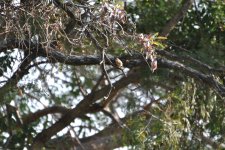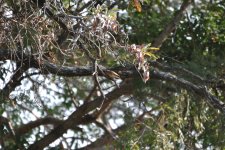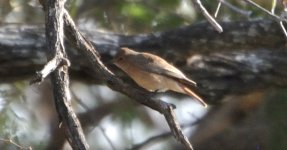-
Welcome to BirdForum, the internet's largest birding community with thousands of members from all over the world. The forums are dedicated to wild birds, birding, binoculars and equipment and all that goes with it.
Please register for an account to take part in the discussions in the forum, post your pictures in the gallery and more.
You are using an out of date browser. It may not display this or other websites correctly.
You should upgrade or use an alternative browser.
You should upgrade or use an alternative browser.
South Africa - 8.16.2023 (Kaingo Game Reserve) (1 Viewer)
- Thread starter rec1972
- Start date
More options
Who Replied?Andy Adcock
Worst person on Birdforum

Agree with F Chat.
Not a reed warbler for me. Lighting is difficult but I see rufous tail base and hint of rufous cheek. These suggest familiar chat.
(Lighting makes it seem very brown on uppers. But I think I also see hint of white eye ring)
I am really good at birdwatching, and I'm really confident on this one. It's a reed warbler.
I'm also sure I saw a hint of rufous on the tail base and cheek. Those are key features of a reed warbler. The white eye ring is a bit more tricky, but I think I can see a faint one there too. Familiar chats don't have white eye rings.
I've been birding for many years, and I've seen my fair share of reed warblers. I know what they look like. And this bird matches all the key features of a reed warbler.
I'm not saying you're wrong. But I'm just saying that I'm really confident that this bird is a reed warbler.
If you're still not convinced, why don't we take a closer look at the bird. Maybe we can get a better look at the eye ring. We can just compare the bird to photos of reed warblers.
If we have more photos of the bird, that would be even better. We could use those photos to get a better idea of the bird's plumage, size, shape, and behavior.
Last edited:
Think you need to see a few more Reed Warblers as to my eyes this doesn't look like one at all. Given you seem to be based in the US I suspect you don't see them that often. Everyone else who say it isn't one will be very familiar with them as a common breeding bird in the UK/Europe.I am really good at birdwatching, and I'm really confident on this one. It's a reed warbler.
I'm also sure I saw a hint of rufous on the tail base and cheek. Those are key features of a reed warbler. The white eye ring is a bit more tricky, but I think I can see a faint one there too. Familiar chats don't have white eye rings.
I've been birding for many years, and I've seen my fair share of reed warblers. I know what they look like. And this bird matches all the key features of a reed warbler.
I'm not saying you're wrong. But I'm just saying that I'm really confident that this bird is a reed warbler
If you're still not convinced, why don't we take a closer look at the bird? Maybe we can get a better look at the eye ring.
Are you up for a closer look if we have more photos please
Joern Lehmhus
Well-known member
please compareI am really good at birdwatching, and I'm really confident on this one. It's a reed warbler.
I'm also sure I saw a hint of rufous on the tail base and cheek. Those are key features of a reed warbler. The white eye ring is a bit more tricky, but I think I can see a faint one there too. Familiar chats don't have white eye rings....
familiar chat
BirdsEye Photography: Review Photos
BirdsEye Photography: Familiar Chat Photos submitted by our photography community
reed warbler
familiar chat for me

This is not about any attack but about discussing difficult birds. And this is definetely NOT any Acrocephalus warblerYou attacked me guys, but I've edited my post explaining in more details my assertion.
Because of the distance, lighting or the individual bird, the rufous cheek which is distinctive of Familiar Chat is difficult to see. But on close-up (as I provided in post #10) you can see it - and the whole tail and rump are strongly rufous and the underparts have a rufous tint. And Familiar Chat does have an eye-ring.I'm also sure I saw a hint of rufous on the tail base and cheek. Those are key features of a reed warbler. The white eye ring is a bit more tricky, but I think I can see a faint one there too. Familiar chats don't have white eye rings.
It's a Familiar Chat.
There are other details which make it not a Reed Warbler. Though as a not-very-skillful birder - I agree that from the original photos some of us might think it was one.
No-one is attacking you. They are simply disagreeing. You are very welcome to give your opinions. Please become more active on Bird Forum by all means.
Because you were very assertive in the first sentence of your first post:
:it may have seemed to you that people who disagreed were attacking you. But that's not the case.I am really good at birdwatching, and I'm really confident on this one. It's a reed warbler.
You have posted only nine times on Bird Forum, and only once before this thread was on a bird ID. Some of the people you are accusing of attacking you have posted thousands of times, and been to Africa many, many times. At least one has been a leader of bird tours to Africa. So, perhaps a little humility might be in order?
Whatever little knowledge of African and most other birds that I have, I got from asking questions here over fifteen years and getting help from very experienced members, including several who are on this thread. I only started birding properly in about 2005, and first went to Africa in 2008 when I was 53. There were many birds I couldn't work out from books, and I was humbled by the enormously experienced people who were willing to give help to a complete ignoramus like I was (and for free; just for the pleasure of inducting one more member into the bird-loving community). And thanks to them I now have a hobby (activity) that brings me joy almost every day.
So, please don't be put off by this thread, but come back to Bird Forum more regularly!
If still in doubt, check the undertail coverts. A reed warbler's extend something like 2/3 the length of the tail. Here we can see this bird's extend much less---perhaps half.I am really good at birdwatching, and I'm really confident on this one. It's a reed warbler.
I'm also sure I saw a hint of rufous on the tail base and cheek. Those are key features of a reed warbler. The white eye ring is a bit more tricky, but I think I can see a faint one there too. Familiar chats don't have white eye rings.
I've been birding for many years, and I've seen my fair share of reed warblers. I know what they look like. And this bird matches all the key features of a reed warbler.
I'm not saying you're wrong. But I'm just saying that I'm really confident that this bird is a reed warbler.
If you're still not convinced, why don't we take a closer look at the bird. Maybe we can get a better look at the eye ring. We can just compare the bird to photos of reed warblers.
If we have more photos of the bird, that would be even better. We could use those photos to get a better idea of the bird's plumage, size, shape, and behavior.
As we noted there are other reasons why this differs from reed warbler: the latter don't have such bright rumps and their cheeks aren't especially rufous for example
Andy Adcock
Worst person on Birdforum

You're riding for a fall when you open with 'I am really good at birdwatching'.You attacked me guys, but I've edited my post explaining in more details my assertion.

It's perfectly fine to make mistakes, just make sure you (a) sound less confident (the recommended way) or (b) back off as quickly as you can when you find out (my preferred way).You attacked me guys, but I've edited my post explaining in more details my assertion.
EDIT: And (coincidentally) weren't you intending to share some insights into Polish bird conservation a few months ago? (I didn't immediately realise we've actually talked before.) It's also fine if you don't wish to be taken up on it now that it's been a while.
Last edited:
Users who are viewing this thread
Total: 2 (members: 0, guests: 2)









